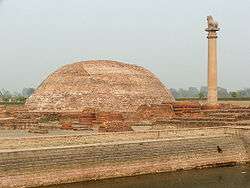Vajji
| Vajji Confederacy | |
|---|---|
| c. 700 BCE–c. 400 CE | |
.png) Vajji and other Mahajanapadas in the Post Vedic period. | |
| Capital | Vaishali[1] |
| Common languages | Maithili, Sanskrit |
| Religion |
Hinduism Buddhism Jainism |
| Government | Republic[1] |
| Raja | |
| Historical era | Bronze Age, Iron Age |
• Established | c. 700 BCE |
• Disestablished | c. 400 CE |
| Today part of |
|
Vajji (Sanskrit: Vṛji) or Vrijji was a confederacy of neighbouring clans including the Licchavis and one of the principal mahājanapadas of Ancient India. The area they ruled constitutes the region of Mithila in northern Bihar and their capital was the city of Vaishali.[1]
Both the Buddhist text Anguttara Nikaya and the Jaina text Bhagavati Sutra (Saya xv Uddesa I) included Vajji in their lists of solasa (sixteen) mahājanapadas.[2] The name of this mahājanapada was derived from one of its ruling clans, the Vṛjis. The Vajji state is indicated to have been a republic. This clan is mentioned by Pāṇini, Chanakya and Xuanzang.[3]
The territory

The territory of Vajji was located north of the Ganges in Bihar and extended up to the Madhesh region. On the west, the Gandaki River was probably the boundary between Vajji and the Malla mahājanapada and possibly also separated it from the Kosala mahājanapada. On the east, its territory probably extended up to the forests along the banks of the rivers Koshi and Mahananda. The capital of this mahājanapada was Vaishali. Other important towns and villages were Kundapura or Kundagrama (a suburb of Vaishali), Bhoganagara and Hatthigama.[4]
Ruling clans
The rulers of Vajji were a confederacy of the eight clans (atthakula) of whom the Vajjis, the Licchavis, the Jñatrikas and the Videhas were the most important. Manudeva was a famous king of the Licchavi who desired Amrapali after he saw her dance in Vaishali.[5] The identities of the other four clans are not certain. However, in a passage of the Sutrakritanga, the Ugras, the Bhogas, the Kauravas and the Aikshvakas are associated with the Jñatris and Licchavis as the subjects of the same ruler and the members of the same assembly.[6]
Vajji administration
Known as the Vajji Sangha "Vajji Confederation", Vajji consisted of several janapadas, gramas (villages) and gosthas (groups). Eminent people were chosen from each khanda (district) as representatives to the Vajji gana parishad "people's council of Vajji". These representatives were called gana mukhyas. The chairman of the council was titled ganapramukha but often he was addressed as a king although his post was neither dynastic nor hereditary. The other executives were the mahabaladhrikrita (a minister of internal security), the binishchayamatya or chief justice, dandadhikrita (other justices) etc.
The capital was Vaishali, a prosperous city. In the introductory portion of the Ekapanna Jataka, Vaishali was described as encompassed by a triple wall with the three gates with watchtowers. The main gosthas were the Licchavis, Mallas and Śakyas. Around 600 BCE, the Licchavis were disciples of Mahavira and Gautama Buddha. During their lifetimes, both Mahavira and Gautama Buddha visited Vaishali several times.
See also
References
- 1 2 3 Patrick Olivelle (13 July 2006). Between the Empires: Society in India 300 BCE to 400 CE. Oxford University Press. pp. 15–. ISBN 978-0-19-977507-1.
- ↑ Raychaudhuri Hemchandra (1972), Political History of Ancient India, Calcutta: University of Calcutta, pp.85-6
- ↑ Raychaudhuri Hemchandra (1972), Political History of Ancient India, Calcutta: University of Calcutta, p.107
- ↑ Raychaudhuri Hemchandra (1972), Political History of Ancient India, Calcutta: University of Calcutta, pp.105, 107
- ↑ http://articles.timesofindia.indiatimes.com/2013-01-31/books/31281015_1_amrapali-nagarvadhu-woman-warrior
- ↑ Raychaudhuri Hemchandra (1972), Political History of Ancient India, Calcutta: University of Calcutta, pp.105-06